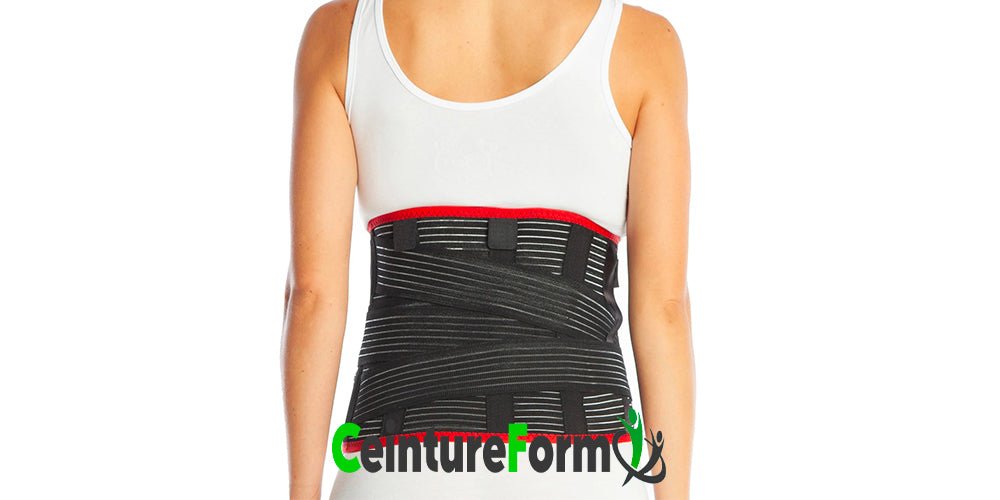Lumbar Belt After Herniated Disc Surgery
Publié le : - Mis à jour le :

The operation of the herniated disc is a common surgical procedure to relieve pain and neurological problems caused by nerve compression. After this procedure, the use of a lumbar belt can play a crucial role in patient rehabilitation and comfort. How to choose and use this accessory to optimize recovery? This article provides you with all the answers you need.
Why use a lumbar belt after a herniated disc operation?
The lumbar belt is often recommended after a herniated disc surgery for several reasons. It provides additional support to the spine by reducing unwanted movements that could compromise healing.
By limiting excessive twisting and bending, it allows patients to gradually resume their daily activities without risking post-operative complications. In addition, it helps reduce pain by providing gentle and constant compression.
Pain relief
After a herniated disc operation, it is common to experience residual pain. The lumbar belt can help pain relief by stabilizing the operated area and minimizing muscle spasms.
Prevention of recurrences
One of the main risks after disc herniation surgery is recurrence. The lumbar belt helps protect the spine during the critical first months when the scar tissue is still fragile.
It acts as a physical barrier against certain sudden actions or movements that can cause a new hernia or additional complications.

Tips for using the lumbar belt
Wearing a lumbar belt is not enough; you also need to know how to use it correctly to maximize its benefits. Here are some practical tips:
- Wearing time: Don't wear your lumbar belt all day long. Use it mainly when you are doing physical activities or when you feel fatigue in your back.
- Adjustment: Always make sure to adjust your belt properly. It should be neither too tight nor too loose.
- Hygiene : Wash your belt regularly to prevent the build-up of sweat and bacteria.
Activities to avoid
After surgery, certain activities should be strictly avoided even when wearing a lumbar belt. Heavy lifting, intense exercises and sudden movements should be avoided during rehabilitation.
Talk to your physical therapist to determine what gentle exercises can be gradually incorporated into your daily routine to gently strengthen your back.
Medical monitoring
Medical follow-up is crucial after herniated disc surgery. Regular visits will allow your doctor to monitor your progress and make necessary adjustments to your treatment.
Please feel free to express any concerns or ask questions regarding the use of your lumbar belt during these visits.

Postoperative rehabilitation and lumbar belt
Postoperative rehabilitation is an inevitable and essential phase after a herniated disc operation. It usually includes physical therapy sessions to restore mobility, strength and promote optimal recovery.
The lumbar belt plays a supporting role during this phase. However, it should not replace the prescribed exercises, but rather come as a complement to provide increased support and comfort.
Recommended exercises
As part of rehabilitation, various exercises are often recommended to strengthen the back muscles and promote better posture. These exercises include:
- Gentle stretches: To improve flexibility and reduce muscle tension.
- Muscle strengthening: Exercises that specifically target the abdominal and lower back muscles.
- Walk : A simple but effective activity to maintain good blood circulation and improve general physical condition.
It is essential to perform these exercises under the supervision of a professional to avoid bad posture or overexertion.
Progressive use of the belt

It is recommended to start using the lumbar belt moderately at first. Gradually extend the wearing time according to your comfort and pain sensations.
Overuse can lead to muscle dependency, which is not desirable. The goal is to support the body while it gains strength and stability.
Alternatives to the lumbar belt
Although the lumbar belt is very useful, other devices and methods can also help with recovery after a herniated disc surgery. These include:
- Orthotics: These orthopedic devices offer more personalized support.
- Corsets: Mainly used in more severe cases, they provide maximum stabilization.
- Complementary medical treatments: Acupuncture, therapeutic massages and electrostimulation.
Post-operative rest
A post-operative rest Adequate rest is essential after surgery. Alternate between periods of rest and light movement according to medical recommendations.
Too much rest can stiffen muscles, while too much activity can further compress the spine. Find a balance that works for your condition with the help of your healthcare team.
Arthrodesis
For some patients, especially those with complex spinal problems, a arthrodesis may be necessary. This procedure fuses two or more vertebrae together to stabilize the spine.
In these situations, the lumbar belt also contributes to the success of recovery by providing essential support during the bone fusion process.
In short, each step of recovery after a herniated disc operation involves special attention and proper care. The lumbar belt is a valuable tool that accompanies patients towards optimal healing, while allowing a safe return to their daily activities.
Recent Articles
- Cherry Tattoo Meanings: Symbols and Ideas
- The key elements of the men's guinguette style
- What color shoes with a royal blue dress
- Which Jacket to Wear with a Navy Jumpsuit: Ultimate Guide to the Perfect Look
- The Loewe it-bag: an icon of contemporary fashion
- Women's gifts at cadeaux.com: ideas and inspiration for all occasions

